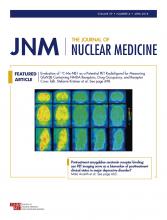See the associated article on page 612.
Overexpression of a membrane-associated target on tumor or immune cells, or of a factor in the tumor microenvironment, is a major determinant of whether a patient can be treated with a monoclonal antibody against such a target. Target expression is often judged on small-tissue biopsies, which do not take into account the possibility of significant intra- and intertumoral heterogeneity of expression. This is particularly true of diffuse intrinsic pontine glioma (DIPG), a pediatric glial tumor of the brain stem for which surgical resection is not possible. Significant heterogeneity in genetic mutations has been shown in studies of the diffuse spread of these tumors across whole-brain autopsy specimens (1,2). Besides gene mutations affecting target expression, tumor targeting of monoclonal antibodies is driven by a complex set of factors resulting in heterogeneity in uptake of monoclonal antibodies by tumors. The affinity of the antibody for its target is relevant. However, also of pivotal importance—for an antibody to even reach its target—is target accessibility, which is associated with, for example, tumor perfusion and intratumoral pressure. Earlier work on tumor targeting of the anti–carbonic anhydrase IX monoclonal antibody girentuximab has shown large variability in immuno-SPECT targeting of the radiolabeled antibody to the tumor antigen within resected specimens of primary renal cell cancer (3). More recently, immuno-PET studies on breast cancer patients by Gebhart et al. have shown that large differences in tumor targeting of trastuzumab can be observed not only between patients but also between metastases in an individual patient (4). An additional strength of immuno-PET is the assessment of the accessibility of a target beyond expression in multidrug treatment regimens. Desar et al. showed that treatment of patients with metastatic renal cell cancer with sorafenib resulted in a significant decrease in radiolabeled bevacizumab uptake in the tumor. Although ex vivo assessment showed that expression of vascular endothelial growth factor (VEGF)–A, the target for bevacizumab, remained intact, the destruction of the tumor neovasculature prevented bevacizumab from binding to its target (5).
In the report by Veldhuijzen van Zanten et al. in this issue of The Journal of Nuclear Medicine (6), direct histologic validation of imaging results in a child with DIPG became possible because she participated in a protocol with 89Zr-bevacizumab immuno-PET only days before her death and because her parents subsequently consented to an autopsy. The availability of a recent MRI scan, an 89Zr-bevacizumab PET/CT scan, and extensive postmortem immunohistochemistry for this patient, in combination with 89Zr tissue counting within a short time, resulted in a unique opportunity to assess the in vivo imaging results without significant bias due to treatment effects or tumor progression.
The 70% lower in vivo uptake of 89Zr-bevacizumab in small tumors is an important observation. Thus, the well-known caveats of partial-volume effects in small lesions (resulting in underestimation of tumoral 89Zr-bevacizumab uptake) and the persisting blood-pool activity (resulting in overestimation of tumoral 89Zr-bevacizumab uptake) do result in a net underestimation of tumor uptake, which needs to be factored in when decisions on drug doses are derived from imaging results. Obviously, when using small, rapidly clearing radiolabeled molecules, the impact of underestimated tumor targeting due to partial-volume effects will be even higher.
It must be appreciated that 89Zr-bevacizumab binds to VEGF, which is a soluble target with a relatively short half-life. Thus, underestimation of VEGF content in tissue samples may have occurred because of washout, resulting in low, nonspecific findings. When 111In-bevacuzimab immuno-SPECT was used in patients with colorectal liver metastases, a lack of correlation was also reported between the level of anti-VEGF antibody accumulation and the level of VEGF-A expression in the tissue as determined by in situ hybridization and enzyme-linked immunosorbent assay (7). It was concluded that this lack of correlation may be due to the inability to visualize the soluble VEGF121 isoform. It was also postulated that enhanced vascular permeability in tumors may play a role in nonspecific 89Zr-bevacizumab targeting. Nevertheless, Veldhuijzen van Zanten et al. did observe higher 89Zr-bevacizumab targeting to areas of microvascular proliferation. Although this may indicate an additional target of 89Zr-bevacizumab, it may very well be that both the 89Zr-bevacizumab targeting and the microvascular proliferation are the result of high local VEGF levels in vivo. It is notable, however, that this observation did not explain all areas of heterogeneous uptake across the specimen, and therefore further exploration of the microenvironment in which DIPG cells grow and infiltrate is warranted. Recent studies have shown a remarkable co-optation of normal neuronal signaling by DIPG cells (8,9), highlighting the complexity of cell–cell interactions during tumor progression. This particular case was also unusual given its apparent lack of the highly prevalent histone H3K27M mutation. What these H3 wild-type tumors represent within the pathogenesis of DIPG is not clear, and extension of the present insightful studies across further tumors within the newly recognized diagnostic entity of “diffuse midline glioma with H3K27 mutation” will be extremely valuable.
In conclusion, extensive ex vivo verification of noninvasive imaging–based assessment of target expression reveals important additional information underpinning the strengths and challenges of molecular imaging as a tool for in vivo immunohistochemistry. This holds especially true when obtaining tissue is not straightforward, such as for brain tumors. Veldhuijzen van Zanten et al. elegantly demonstrate that the untimely death of a very young patient with pontine glioma did result in unique and important scientific information.
DISCLOSURE
No potential conflict of interest relevant to this article was reported.
Footnotes
Published online Dec. 7, 2017.
- © 2018 by the Society of Nuclear Medicine and Molecular Imaging.
REFERENCES
- Received for publication November 21, 2017.
- Accepted for publication November 27, 2017.







